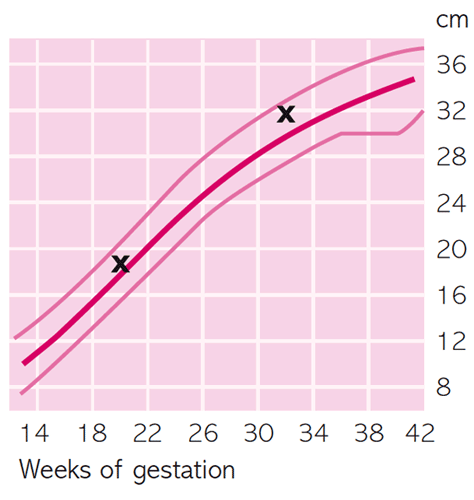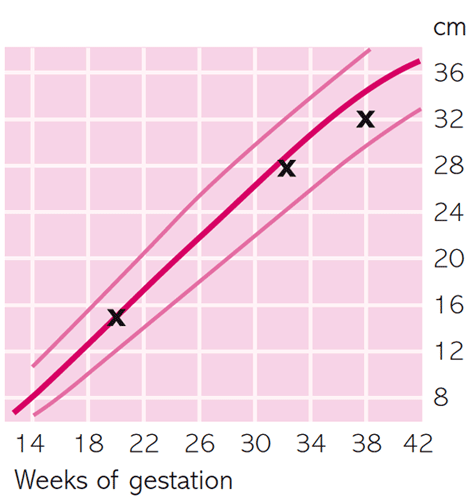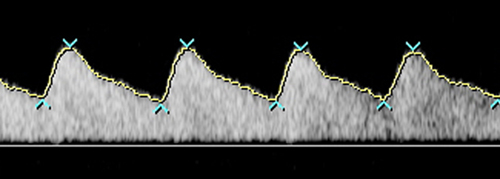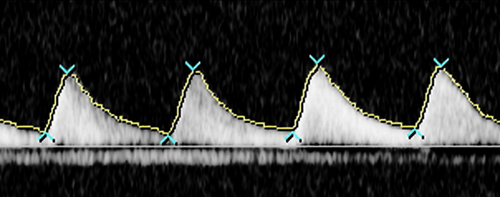You are 27 Weeks and 3 Days 88 days to go…
Pregnancy is a subject about which everybody has an opinion they want to share with you, whether you like it or not.
Your baby today
This baby is at the end of a yawn. Your baby is yawning in a
more coordinated way now with one yawn often following another. It may
look as if this image shows the fingertips in the bottom right but in
fact it is a foot, nearly brought up to the mouth.

Although you may
have become very proud and protective of your belly, it can be
extremely irritating if other people become overprotective of you. You
may find that everyone has an opinion on your pregnancy, and what you
should and should not be doing to stay healthy. Some women find all the
attention comforting, but others find it frustrating or suffocating. If
you’re someone who finds all the advice difficult to handle, try to
remember that people mean well.
Of course, it’s your
body, and you’ll do what is best for you and your baby. If it’s all
getting too much, then try talking to the main offenders, often a
partner, mother, or mother-in-law. Explain that you’re trying your best
and that you’re aware of what you should and shouldn’t do while you’re
pregnant and are following the advice of your doctors. Politely thank
them for their input and reassure them that you’re taking good care of
yourself and your baby.
… Your health
Blood pressure checks
About 8 percent of women have problems with high blood pressure in pregnancy. High blood pressure can be caused by preeclampsia,
a serious condition that also leads to protein in the urine.
Preeclampsia can affect the liver and kidneys and, if untreated, lead to
eclampsia or seizures. If you have preeclampsia, your doctor will
closely monitor your blood pressure. High blood pressure can affect also
your baby, so medication may be recommended. Don’t stop the medication
without your doctor’s okay.
On smelling good
Are you wafting through
pregnancy feeling fresh as a daisy? It’s rarely discussed, but being
pregnant may make you feel less fragrant than usual, not least because
you will sweat more than before—although it’s unlikely that anyone else
will have noticed. An increase in vaginal discharge is also nothing to
worry about, but if it smells offensive or is yellowish or greenish in
color, you could have an infection so see your doctor. To stay smelling
sweet:
Shower or bath regularly and apply deodorant every time. Take handy wipes with you to stay fresh all day.
Use body sprays and lotions if your usual fragrance doesn’t smell “right”: they tend to be lighter and are less likely to cause headaches.
Avoid wearing tight clothing: wear loose clothes in natural fabrics, which absorb sweat and allow your skin to breathe.
Wear cotton underwear, and change it more often, if necessary.
Use disposable panty liners, if needed, to stay feeling fresh.
Choose the perfume you put on carefully since you may find that some scents, even one you’re used to wearing, make you feel nauseous or light-headed during pregnancy.

Assessing Fetal Growth and Well-being
In addition to
monitoring your own health and well-being throughout your pregnancy, the
doctor will also assess how your baby is growing and will refer you for
further tests if she has any concerns about your baby’s well-being.
Measuring your baby
In a low-risk
pregnancy, the abdomen is measured at prenatal visits to assess the
baby’s growth. The measurement in centimeters from the top of your pubic
bone to the top of your uterus (the fundus) should be about the same as
the number of weeks you are pregnant, with an allowance of up to 2 cm
either way. For example, if you are 26 weeks’ pregnant, you should
measure between 24 and 28 cm. Your fundal height can be measured between
24 and 36–37 weeks, since once your baby “drops” into the pelvis in
late pregnancy, the measurement may not reflect his or her true size. If
there is a variation of 3 cm or more, your doctor will arrange for an
ultrasound to check your baby’s growth (see Growth charts)
and the amount of amniotic fluid. If the scan indicates a problem, the
doctor will arrange for scans every two weeks since analyzing growth
patterns over time gives a more accurate assessment of whether your
baby’s growth is normal.
In certain cases, for
example if a woman is obese, in twin pregnancies, and where there are
large uterine fibroids, the only accurate way to measure growth is by
ultrasound.
Measuring your abdomen helps the doctor monitor your baby’s growth.

Measuring growth with ultrasound in late pregnancy
By late pregnancy, the
length of your baby can no longer fit on the screen and so his or her
size will be calculated by combining several measurements in a
mathematical formula, as is done at the 20-week scan .
Measurements include the width of the head (biparietal diameter),
circumference of the head, and the abdominal circumference, which are
plotted on a graph over a period of time (see Growth charts).
The length of the upper leg bone (femur length) may also be measured.
If your baby is smaller than the 10th percentile or has a small abdomen,
you may have more tests to assess his or her well-being (see Your baby’s well-being). A measurement above the 90th percentile can be a sign of gestational diabetes and will need investigating. Also, if your baby is at the larger end of
the scale, your doctor may recommend you have a cesarean delivery.
Your baby’s well-being
If there are concerns
over your baby’s growth, you may be referred for a “non-stress” test
and/or biophysical profile testing, which observe how your baby responds
to stimuli and if there are signs of fetal distress. If you have a
known condition that can affect your baby’s growth (see Growth charts),
your doctor may arrange for you to have one or both of the above tests
once or twice a week after about 32 weeks’ gestation as a matter of
routine, whether or not there are concerns about your baby’s growth.
Some hospitals also perform special scans, known as Doppler scans to assess placental blood flow.
A non-stress test
This test assesses
your baby’s well-being. An external transducer is placed on your
abdomen to listen for accelerations in your baby’s heart rate that last
about 15 seconds. The mother may or may not notice any fetal movement
during these accelerations. The test result is thought to be
“reassuring” if the heart accelerates twice over 20–30 minutes, and
there are no large decelerations. About 10–20 percent of babies have a
test with less than two accelerations. This doesn’t necessarily mean
there is a problem: your baby may just have been asleep, and the test
may be repeated.
A biophysical profile (BPP)
If, after the
non-stress test, your doctor has concerns about your baby, a biophysical
profile (BPP) may be done. A BPP combines the results of a CTG reading
with a scan to evaluate four factors: the volume of amniotic fluid,
fetal movement, fetal muscle tone and posture, and fetal breathing. Two
points are given for each part of the test, so a “reassuring” BPP result
would be eight points.
Growth charts
If your doctor has any concerns about your baby’s growth later in pregnancy,
he or she may arrange for scans to be done over a period of time so
that your baby’s growth can be plotted on a chart and monitored.
Individual measurements will be taken of the head, abdomen, and limbs.
Measurements of the head and abdomen are most important since an unequal
growth pattern in these areas may indicate a particular problem.
The three lines on the
graphs here represent different growth rates. The red line in the
center, referred to as the 50th percentile, shows an average pattern of
growth. The thinner lines above and below, the 90th and the 10th
percentiles, show the top and bottom ranges of normal growth. Since the
head and abdominal circumferences are measured over time and plotted on a
graph, a pattern of growth becomes clear. Here, the head is growing
normally, but growth has slowed in the abdomen, possibly due to a
placental problem that in itself may be caused by a condition in the
mother. For example, conditions such as high blood pressure or diabetes
can affect placental blood flow. If the blood flow to the baby is
restricted, this can result in the oxygen and nutrients carried in the
blood being diverted to the baby’s most vital organs, the brain and
heart, rather than to the abdominal organs, which results in unequal
growth patterns in the head and abdomen.
Head circumference

Abdominal circumference

Doppler scans
A Doppler scan is a special scan that analyzes blood flow through the placenta.
If the placenta is functioning well, the blood flows easily. If there
is a problem in the placenta, it is resistant to the blood flow and the
baby’s heart has to work harder to pump blood. In extreme cases, there
are periods between your baby’s heartbeats of no blood flow or reversed
blood flow through the umbilical cord. In this case, an early delivery
may be suggested unless you’re very premature.
A normal Doppler reading shows the continuous blood flow
to the baby via the placenta. At the beginning of a heart cycle, the
pressure is high; it then dips at the end of the cycle, but doesn’t ever
stop.

An abnormal reading
indicates that there is resistance to blood flow in the placenta,
resulting in very little or no flow at the end of the cycle. The baby
may not receive sufficient oxygen, which can affect growth.

| Q: |
I’ve heard about “kick counts.” Should I be doing these?
|
| A: |
Fetal movement counting, or “kick counts,” is one way to
monitor the well-being of your baby from 28 weeks onward. However it can
cause undue worry to moms and other indicators of movement are
important. These include noting a change in the pattern of movement and
inactivity when your baby is normally active. Your doctor may ask you to
write down your baby’s normal movement and call her immediately if
there are any changes in the pattern.
|
| Q: |
Can my baby move too much?
|
| A: |
Usually, the more movement the better, even if this keeps you
up at night or causes discomfort. An active fetus is not a sign that
you’ll have a restless baby or hyperactive child.
|